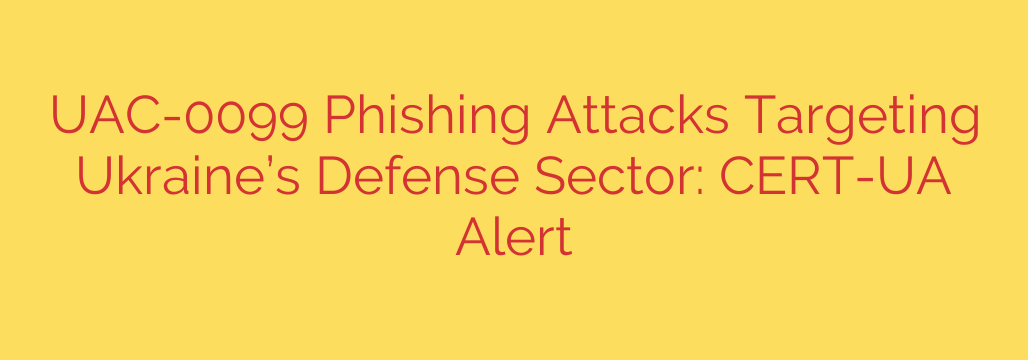
UAC-0099 Escalates Cyber Attacks on Ukraine’s Defense Sector with Sophisticated Phishing
A persistent and aggressive threat actor, identified as UAC-0099, is actively conducting targeted cyber espionage campaigns against Ukraine’s defense forces. This group is leveraging sophisticated phishing techniques to deploy malware, aiming to steal sensitive military and operational data. Understanding their methods is the first step toward building a robust defense.
This latest wave of attacks demonstrates a clear focus on high-value targets within the Ukrainian government and military. The primary goal appears to be intelligence gathering, making these campaigns a significant threat to national security.
The Attack Chain: From Email to Espionage
The attack begins with a carefully crafted phishing email. These emails are designed to look legitimate, often impersonating official communications or containing urgent subject lines to prompt immediate action. The success of the entire operation hinges on a user’s trust and a single click.
Here’s a step-by-step breakdown of how the UAC-0099 attack unfolds:
The Lure: The victim receives an email containing a malicious attachment, typically a RAR archive. These archives are often password-protected, with the password provided in the body of the email. This is a common tactic used to bypass some automated email security scanners.
The Payload Delivery: Inside the archive, the user finds what appears to be a standard document. However, the true payload is a malicious LNK file (a Windows shortcut). These LNK files are disguised with document-like icons to trick the user into opening them.
Execution and Deception: Once the user clicks the LNK file, it executes a hidden command. This command typically runs a PowerShell script, which acts as a downloader. To avoid suspicion, a decoy document is often opened simultaneously. The user sees a harmless file and may not realize that malicious activity is happening in the background.
The Final Malware: LONEPAGE: The PowerShell script connects to a remote server controlled by the attackers and downloads the final malware payload. In these recent campaigns, the malware has been identified as LONEPAGE, a specialized tool designed for espionage. LONEPAGE allows the attackers to exfiltrate files, execute commands, and maintain persistent access to the compromised system.
Key Characteristics of the UAC-0099 Campaign
This campaign is not a random, scattergun attack. It is defined by its precision and specific choice of tools. Key takeaways for security teams include:
- Highly Targeted Social Engineering: The phishing emails are not generic. They are tailored to appeal specifically to personnel within the defense sector, using relevant themes and language.
- Abuse of LNK Files: The reliance on malicious LNK files within archives is a core tactic. Many security policies and user training programs focus on executable files (.exe) but may overlook the danger posed by shortcuts.
- Multi-Stage Infection Process: The attack uses several stages to deliver the final payload. This complexity helps evade detection by security software that only analyzes the initial attachment.
- Primary Goal is Espionage: The deployment of the LONEPAGE malware confirms that the attackers are not interested in financial gain or ransomware. Their objective is the theft of sensitive government and military information.
Actionable Security Measures to Mitigate the Threat
Protecting against sophisticated threats like UAC-0099 requires a multi-layered security approach that combines technology, policy, and user education.
1. Enhance Email Security and Filtering
Implement advanced email security solutions that can scan inside archives and identify suspicious scripts. Configure email gateways to block or quarantine emails containing LNK files or other uncommon attachment types from external sources.
2. Bolster User Training and Awareness
The human element remains the most critical line of defense against phishing. Conduct regular, mandatory security awareness training focused on:
- Identifying the signs of a phishing email (e.g., mismatched sender addresses, urgent language, unexpected attachments).
- Never opening attachments or clicking links from unverified sources.
- Understanding the danger of file types like LNK, even if they appear to be documents.
- Reporting any suspicious emails immediately to the IT or security department.
3. Harden Endpoint Security
Deploy and properly configure Endpoint Detection and Response (EDR) solutions. An EDR tool can detect malicious PowerShell activity, unusual process execution originating from an LNK file, and unauthorized network connections, allowing for a rapid response.
4. Restrict Script Execution
Implement policies to control the use of scripting languages like PowerShell. For most users, PowerShell execution should be disabled or restricted to signed scripts only. This single step can break the attack chain and prevent the LONEPAGE malware from being downloaded.
5. Monitor for Indicators of Compromise (IOCs)
Security teams should proactively hunt for IOCs associated with UAC-0099, including known malicious file hashes, domain names, and IP addresses. Subscribing to threat intelligence feeds can provide up-to-date information on the tools and infrastructure used by this and other threat actors.
Ultimately, vigilance is key. The tactics employed by groups like UAC-0099 will continue to evolve, making it essential for organizations—especially those in critical sectors—to maintain a proactive and adaptive security posture.
Source: https://securityaffairs.com/180896/apt/cert-ua-warns-of-uac-0099-phishing-attacks-targeting-ukraines-defense-sector.html








